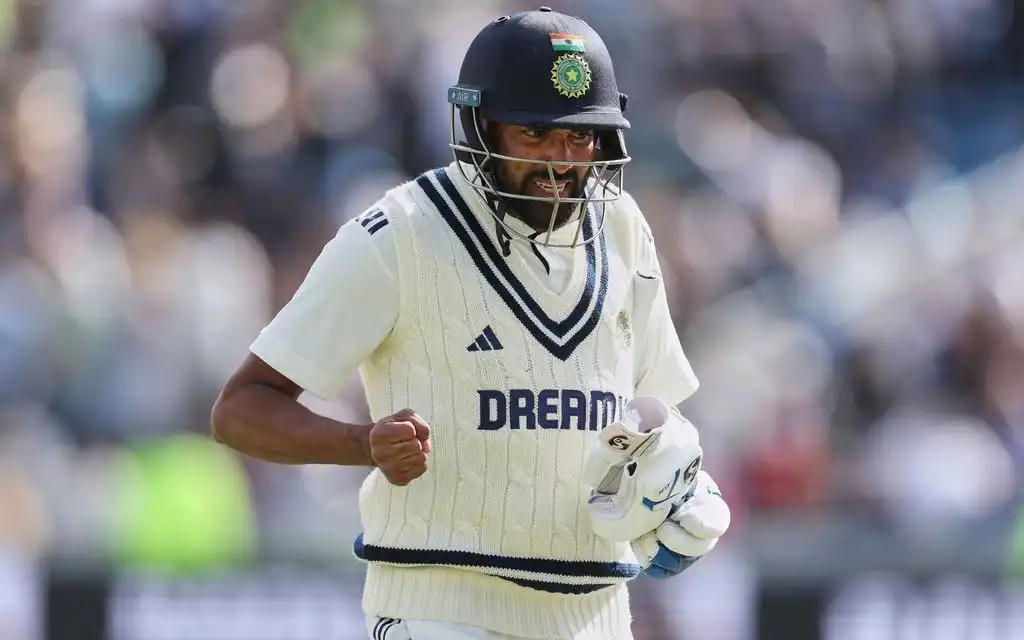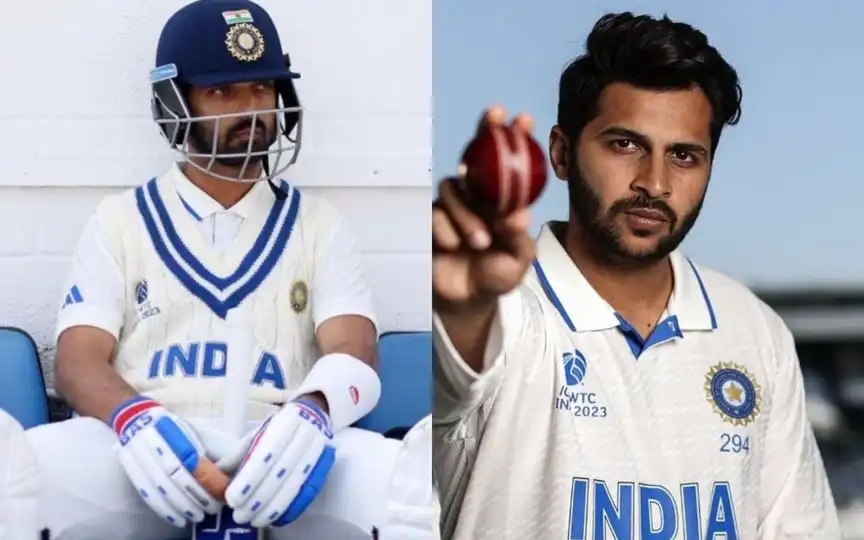 Mohammed Siraj Getting Hit - (Source : AP)
Mohammed Siraj Getting Hit - (Source : AP)
"I just saw on Twitter somebody saying that Indian batting is like a Dobermann dog. The head is good. The middle portion is okay. There is no tail at all." — Dinesh Karthik
These words, which drew loud laughter from presenters, perfectly capture the predicament of the Indian cricket team after their humiliation in the first Test against England at Headingley. Despite being 359/3 in the first innings after Day 1, India somehow managed to lose the match.
Questions were raised about Shubman Gill’s captaincy and fingers were pointed at the bowlers, but the real issue—the poor performance of the tail—was brushed aside, becoming a subject of amusement. Analysts compared Gill’s aggression to Virat Kohli’s, or lamented that Jasprit Bumrah lacked support from his bowling partners, but few highlighted the glaring fact: the top five Indian batters amassed 721 runs in the first Test, while the lower six managed just 65 runs.
Why Is Tail-Enders Struggling For India
India suffered two major collapses in the first Test, ultimately proving decisive in their defeat. This is not a new problem; the Indian tail has repeatedly failed over the years, and its shortcomings are now expected rather than criticised.
Cricket has never been a sport where only the top six are meant to score runs, while the lower order is devoid of any responsibility to add runs to the total. Bowlers are not expected to play stylish drives or hit towering sixes, but they can at least survive—something that has been consistently missing from India’s recent performances.
The rest of the world, however, takes its tail-enders seriously. Teams like Australia, England, New Zealand, and South Africa have lower orders that regularly frustrate opposition attacks and contribute crucial runs. The difference is cultural and tactical: other teams expect and prepare their tail to contribute, while India’s management seems to accept the status quo—that bowlers are there to bowl, and runs from them are a bonus.
Looking at India’s History
Barring rare exceptions—like Mohammed Shami and Jasprit Bumrah’s match-saving heroics at Lord’s in 2021—there are hardly any memorable knocks from India’s tail. Collapses, on the other hand, are frequent. In the 2011 World Cup, India lost just one game, against South Africa, when they collapsed from 283/5 to 296 all out. More recently, India set a world record by losing six wickets for no runs against South Africa at Newlands in January 2024.
The problem persists under new leadership. During a tour of Sri Lanka under Gautam Gambhir, the Men in Blue were 189/5 while chasing a 231-run target and still failed to win the match. The situation was such that India required a single run to win with two wickets in hand, but still threw the wickets away. According to Wisden, India’s last five wickets have averaged just 18.93 since the start of 2024—the worst among the nine nations in the World Test Championship.
Batting Averages of India’s Tail
- Jasprit Bumrah: 6.77 (Tests), 7.58 (ODIs), 2.66 (T20Is)
- Mohammed Siraj: 4.78 (Tests), 7.58 (ODIs), 7 (T20Is)
- Mohammed Shami: 12.09 (Tests), 7.75 (ODIs), 3 (T20Is)
- Kuldeep Yadav: 13.26 (Tests), 9.85 (ODIs), 11.50 (T20Is)
Lets Compare Indian batters average to rest of the team.
| Teams | Players | Tests (Average) | ODIs (Average) | T20Is (Average) |
| Australia | Pat Cummins, Mitchell Starc, Josh Hazlewood | 16.98, 20.5, 11.97 | 14.51, 12.02, 16.37 | 10.53, 9.80, 9.66 |
| England | Stuart Broad, Anderson, Mark Wood, Chris Woakes | 18.03, 8.96, 15.82, 26.42 | 12.3, 7.58, 12.92, 23.81, | 7.37, 1, 13.5, 16.33 |
| New Zealand | Tim Southee, Klye Jamieson, Trent Boult | 15.48, 19.63, 15.81 | 12.13, 23, 9 | 11.22, 16, 8.28 |
| South Africa | Kagiso Rabada, Marco Jansen, Lungi Ngidi | 11.85, 22, 4.85 | 14.85, 24.42, 11.27, | 17.33, 18.44, 8.20 |
| Pakistan | Haris Rauf, Shaheen Afridi, Naseem Shah | 6, 8.03, 7.57, | 8, 13.05, 23.55 | 6.66, 12.41, 7.28 |
Looking at the table, Australia, England, New Zealand, and South Africa all have better tail-enders than India. Notably, the Indian tail only averages better than Pakistan in Tests, but lags in ODIs and T20Is, which highlights the problem that lies in Indian cricket.
Why Tails Are Key to Trophies
As mentioned above, often bowlers are not expected to bat, but this is where the difference lies between a trophy. After the 2013 Champions Trophy, India had to wait 11 years for an ICC trophy, whereas Australia kept on adding silverware to their total, why? Because of the equal distribution of runs among the top-half and bottom-half players.
Looking at other teams, Australia have Mitchell Starc, Pat Cummins and Josh Hazlewood. Starc scored 99 against India, and nearly saved Australia in the WTC final with a fifty-plus score. Whereas, Pat Cummins played a key role in the crucial partnership against Glenn Maxwell, which saw Australia stun Afghanistan and stay alive in World Cup 2023, which they eventually won.
While the limelight was on Maxwell's one-legged knock, the focus should also be on the Australian captain who scored 12 (68) and didn't throw his wicket away from one end.
Similarly, for New Zealand, they met India in the 2021 WTC final, where the then Virat Kohli-led India crumbled for 217 runs. In reply, New Zealand were also 162/6 and the team from the subcontinent had the chance to restrict them to a lower total, but Tim Southee and Kyle Jamieson aggregated 51 runs to give the Kiwis a lead, which eventually was the point of difference and Black Caps won their first-ever ICC title.
Even South Africa, who were fighting hard to qualify for the WTC final and Pakistan were their final hurdle. In the 1st Test, Proteas had to chase 150 runs but lost eight wickets for 99 runs. When the odds were favouring Pakistan, Kagiso Rabada and Marco Jansen stepped up and stitched a fifty-plus stand to help Proteas qualify for the finals.
Should We Start Questioning? Yes, We Should
It is high time India’s management and selectors take the lower order’s batting seriously. While selection should remain based on bowling prowess, batting ability must also be a criterion. The BCCI, as the richest cricket board, should invest in specialist coaching for tail-enders to help them add those crucial 30–40 runs at the end of an innings—rather than becoming a laughingstock on the internet.
India’s tail must start wagging if the team is to realise its full potential and compete consistently for trophies. The mindset must change: runs from the lower order are not a luxury, but a necessity.
Conclusion
India’s tail-end failures are not just a laughing matter but a serious weakness that has cost them matches and trophies. The management must address this issue with targeted coaching and a shift in mindset, making every run count—regardless of who is at the crease.
.jpg)
.jpg?type=mq)
.jpg?type=mq)

.jpg?type=mq)
